Citizen scientists, game wardens, researchers plus their students and even a few bonafide professional collectors explored western Canada plus other parts of this vast continent, some journeying around the globe. What unites them all is their trust in the Cowan Tetrapod Collection to house, in perpetuity, their biodiversity legacy. Only a few have been honoured so far. If you are interested in contributing to this archival project please contact us.
Click the contributor’s name below to learn more about each of these intrepid citizen scientists and researchers!
* Please note this webpage is under construction. Please check back soon!

Ian McTaggart Cowan pushing the train-car on Whitesail/Eutsuk portage (Jim Van Tine Portage) during his and Joyce’s honeymoon. (1936)

Ian McTaggart Cowan and Bristol Foster at Rose Spit, Haida Gwaii (Queen Charlotte Islands). (1960) – Bristol Foster was a grad student and contributed specimens to the Cowan Tetrapod Collection. Bristol and artist Robert Bateman did a famous drive across Africa in 1961 in a Land Rover.

Ian McTaggart Cowan, Frank Bryant, Syd Williams, and Kathleen Bryant in front of a cabin at Snaring River, Jasper. (1930)

Ian McTaggart Cowan with V. Udvardi and cameraman Robert Reid filming for his television series The Living Sea, a precursor to the Nature of Things. Photo by UBC Dept. of Extension Services.
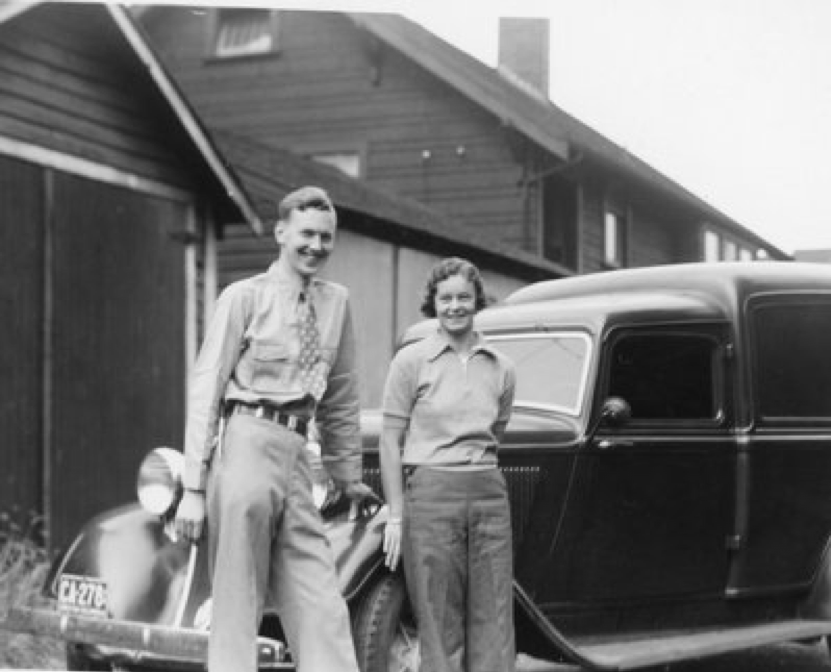
Ian McTaggart Cowan and Joyce McTaggart Cowan with Provincial Museum truck. (1937) – Ian married Kenneth Racey’s daughter, Joyce.
Images have been made available for research and study by UVic Special Collections and University Archives. For other uses, please contact UVic Special Collections and University Archives (250) 721-8257.
Contributor Snapshot
Professional avian collector and preparator, the life of Abidul Rasool is a bit of a mystery except for for the years of 1950 and 1951. During this period, Rasool and Wilfred J. Plowden-Wardlaw were under contract to the Yale Peabody Museum to collect and prepare avian skins from Trinidad and Tobago, Guyana, and Dominic. The Peabody Museum Rasool Collection of ~813 birds is referred to in numerous journal articles about the avian fauna of Trinidad and Tobago.
Contribution to the Cowan Tetrapod Collection
It is safe to conjecture that the Cowan Tetrapod Collection acquired its Rasool specimens via his expedition mate, Plowden-Wardlaw, a BC resident. Often prepartors trade skins with each other for inclusion in their personal collections. Plowden-Wardlaw is one of the major contributors to the Cowan Tetrapod Collection avian collection. The majority of these 33 Rasool Trinidadian avian study skins are tanagers and all of them are passerines. The 3 Rasool study skins from what was then British Guiana (Guyana) are all Charadriiforms (2 shorebirds and a tern). As per VertNet, the Peabody and the Beaty are the only two museums that house A. Rasool 1950’s avian specimens.


B005478: Over 2/3 of the 33 Rasool birds from Trinidad and Tobago are tanagers as is this male Purple Honeycreeper. Despite its name, this bird has magnificent blue plumage.
Researched and written by Ildiko Szabo

Alan Best, 1910-2001. Curator of the Stanley Park Zoo.
Contributor Snapshot
Alan Best was Curator of Stanley Park Zoo for over 20 years. Previously, Best worked for Julian Huxley and was appointed Assistant Zoo Curator of the Regent’s Park Zoo, London, when Huxley was appointed the Curator. In his early years, Best studied art in Paris and as a professional sculptor designed figurines for Wedgewood. After serving in WWII, he made a living as a professional zoo animal collector for a few years prior to returning to his boyhood home on Saltspring Island.
Contribution to the Cowan Tetrapod Collection

B009582: On display in the large avian display cabinet, this Emperor Penguin which formerly lived at the Stanley Park Zoo is often mentioned by BBM visitors as one of their very favourite specimens.
The Cowan Tetrapod Collection has an excellent penguin collection due to Alan Best’s keen interest in these bird and his international recognized expertise of the care and breeding of this taxa. Best made several expeditions to the Antarctic to capture different penguin species for the Stanley Park Zoo much to the delight of zoo visitors. Birds that died often found a new home at the Cowan Tetrapod Collection. One such bird is the taxidermied Emperor Penguin on display at the BBM. The number of birds directly attributed to Best in our collection is small but they greatly contributed to the biodiversity of the collection (King Penguin egg, Peruvian Meadowlark and an Australian Black Swan). The Cowan Tetrapod Collection has many avian and mammal specimens from the Stanley Park Zoo which either have no collector listed or the preparator’s name is listed. This include numerous monkeys and kangaroos, a Red Panda, an Asian Elephant, a flamingo, toucans and off course many of our penguins. The friendship between members of the Stanley Park Zoo staff and what was then the UBC Vertebrate Museum created a wonderful legacy which greatly expands the biodiversity of our collection for everyone to enjoy.
Researched and written by Ildiko Szabo

Kovacs A., 1903-1999. Taxidermist, professional museum specimen collector and natural history guide from ~1950 to ~1983. This image of Andor Kovacs appears as part of the dedication to their father (or grandfather) of the authors of The Illustrated Handbook of the Birds of Patagonia.
Contributor Snapshot
In the 1950s, Andor Kovacs with his wife Yolan Molnar de Kovacs, their six sons and one daughter relocated to El Bolsón, Province of Rio Negro, Argentina. Four of the sons shared their father’s keen interest in biology. For decades, this family of taxidermists and natural history guides helped created global awareness of the tetrapod biodiversity of Patagonia. Kovacs received commissions and shipped prepared mammal, bird, and amphibian research specimens around the world. The earliest A. Kovacs specimen currently listed on VertNet (a multi-museum search engine) is an American Kestrel collected in March 1950 with the last specimen listed being a Chilean Four-eyed Frog collected in November 1983.
Major collections of Patagonian specimens prepared by Andor Kovacs are housed in Europe at the Naturalis (Netherlands), Muséum d’Histoire Naturelle de la Ville de Gèneve (Switzerland), and Uppsala Universitet Evolutionsmuseet (Sweden). In North America, the largest collection of A. Kovacs specimens is at the Natural History Museum of Los Angeles County having ~1,850 birds and mammal skins. Here in Canada, the Royal Ontario Museum has a collection of 366 Patagonian birds prepared by this master taxidermist, Andor Kovacs.
 In 2005, three of Andor Kovacs’s sons plus one grand-son published Spanish and English editions of Illustrated Handbook of the Birds of Patagonia. This publication was a multi-generational project. The backrooms of the private family museum, Museos Ornitologico Patagonica, house an impressive reference collection of over 240 species of Patagonian avian round skins prepared by different family members plus have exceptional taxidermy displays on exhibit. The authors used this bird collection plus the bird lore amassed by this remarkable family to write and illustrated this massive book.
In 2005, three of Andor Kovacs’s sons plus one grand-son published Spanish and English editions of Illustrated Handbook of the Birds of Patagonia. This publication was a multi-generational project. The backrooms of the private family museum, Museos Ornitologico Patagonica, house an impressive reference collection of over 240 species of Patagonian avian round skins prepared by different family members plus have exceptional taxidermy displays on exhibit. The authors used this bird collection plus the bird lore amassed by this remarkable family to write and illustrated this massive book.
Contribution to the Cowan Tetrapod Collection
The two Andor Kovac bird specimens housed at the Cowan Tetrapod Collection expand the biodiversity of our holdings.
B012848, an Aplomado Falcon completes our collection of the six falcons that breed within the ABA Area (American Birding Association area is defined as the 49 continental United States, Hawaii, Canada and the French islands of St. Pierre and Miquelon plus adjacent waters). Correspondence has been lost but most probably a former curator of the Cowan Tetrapod Collection contacted the Los Angeles Museum (Natural History Museum of Los Angeles County) and arranged a specimen trade. Leg tags are never removed from specimens. On the reverse side of the Los Angeles Museum tag (near the colour corrector card in this image) is scribed: El Bolstón, Rio Negro, Argentina: June 3, 1961; Andor Kovacs.
The colouration of the Cowan Tetrapod Collection other Kovacs skin is most un-Cotinga-like. The Cotinga passerine bird family is known for its outrages iridescent blue and purple plumages. To North American birders, this Rufous-tailed Plantcutter (B012847) with its formidable finch-like beak might bring to mind a zany variation of our local Grosbeaks species.

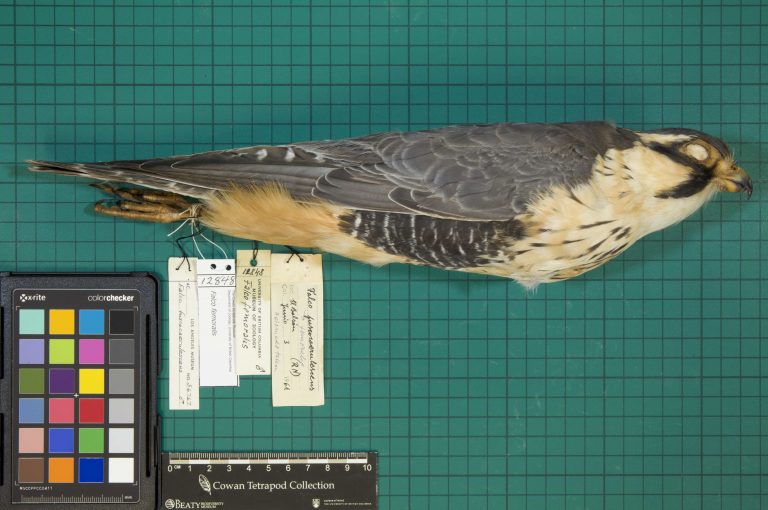
Researched and written by: Ildiko Szabo
Contributor Snapshot
First (BC) Provincial Game and Forest Warden . The BC Department for the Protection of Game and Forests was created on 1st July 1905. Both as BC’s first Provincial Game and Forest Warden and as head of this newly created government department, A. Bryan Williams helped shape what is today’s BC Minister of Forests, Lands, Natural Resource Operations.
Contribution to the Cowan Tetrapod Collection
The oldest mammal sourced from the Thompson-Nicola region housed at the BBM was collected by Williams in 1908. This Mule Deer skull from Lillooet is the first of many tetrapod specimens donated to the Cowan Tetrapod Collection by BC Game Wardens. Today this tradition lives on. Annually BC Conservation Officers plus many other BC Ministry of the Environment and Climate Change Strategies staff donate a wide variety of common, unusual and occasionally blue listed birds, mammals, and reptiles frozen cadavers that are turned into government offices.

This image is page 2 of a BC Conservation Officer Service report: The Beginning 1905-1918. Click this link to read all 7 pages.
Researched and written by Ildiko Szabo
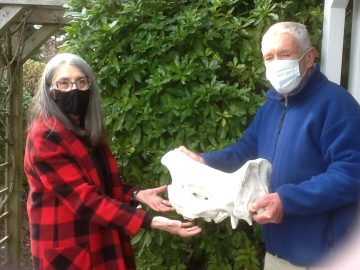
Dr. Derek Nurse, 1939- . Henrietta Harvey Research Professor, Memorial University; currently Professor Emeritus, Fellow of the Royal Society of Canada. Dr. Nurse handing over his Eastern Black Rhinoceros skull to Ildiko Szabo, Cowan Tetrapod Collection Collections Curator. Photograph taken by Margaret Nurse outside their home in Victoria.
Contributor Snapshot
Author of ten books, scores of journal articles, Dr. Derek Nurse was made a Fellow of the Royal Society of Canada for his groundbreaking work in linguistics. His specialty is the historical and modern development of the Swahili and the Bantu Languages. Nurse did his undergrad in Manchester, UK, his Masters at Berkeley, CA and his PhD in Dar es Salaam, TZ. Both for graduate work and for subsequent research, Nurse has travelled extensively in East Africa.
Contribution to the Cowan Tetrapod Collection
Nurse spent 8 years in Tanzania. One day while driving near Arusha National Park, he spied this rain-drenched sun-bleached Eastern Black Rhinoceros skull by the side of the road and decided to rescue. After returning to Canada, this skull had a place of pride in his living room and sparked many a conversation. For a time, it provided hands-on experience to Memorial University biology students. In 2021, Nurse decided to donate it to the Cowan Tetrapod Collection to make the whereabouts of this skull known to the greater research community via VertNet. In 2020, the estimated Eastern Black Rhinoceroses population in Tanzania was ~80 individuals none of which reside in or near Arusha National Park. This skull, M019610 is representative of a now-extinct population.

The sex of M019610 Diceros bicornis michaeli is unknowable based on morphology alone. Looking at the teeth, (wear and how many) tells us that this young rhino with its impressive 52.5 cm long skull was 3.5 – 4 years old. This youngster had two horns but note that the skull is devoid of bony protrusions. Rhino horns are more like out of control dreadlocks than calcified bone and dentine Their horns are entirely composed of keratin as is human hair.
Researched and written by Ildiko Szabo
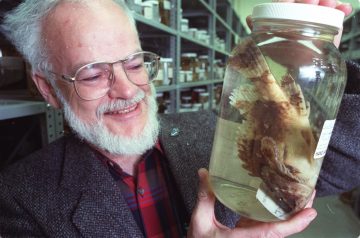
Dr. Donald E. McAllister, 1934-2001. First Curator of Fishes at the Canadian Museum of Nature (photograph courtesy of the Canadian Museum of Nature).
Contributor Snapshot
Born in Victoria, Don McAllister did three degrees at UBC finishing his PhD in 1964: The evolution of branchiostegal rays in teleostome fishes. At what is now the Canadian Museum of Nature (CMN), McAllister was hired as the first Curator of Fishes, a post he filled from 1958-1986. Under his watch, this national collection grew from ~4,638 specimens to over 410,000 specimens. From 1986 until he retired from the CMN in 1993, McAllister devoting his time to environmental issues. In 1950, he married a fellow UBC doctoral student, Nancy Mahoney.
Contribution to the Cowan Tetrapod Collection
The UBC Fish Collection has 9 specimens collected by Don McAllister. Ever interested in aquatic vertebrates, Don donated 3 frogs, 3 toads, and 1 snake to the Cowan Tetrapod Collection. He also donated a North American Deermouse.
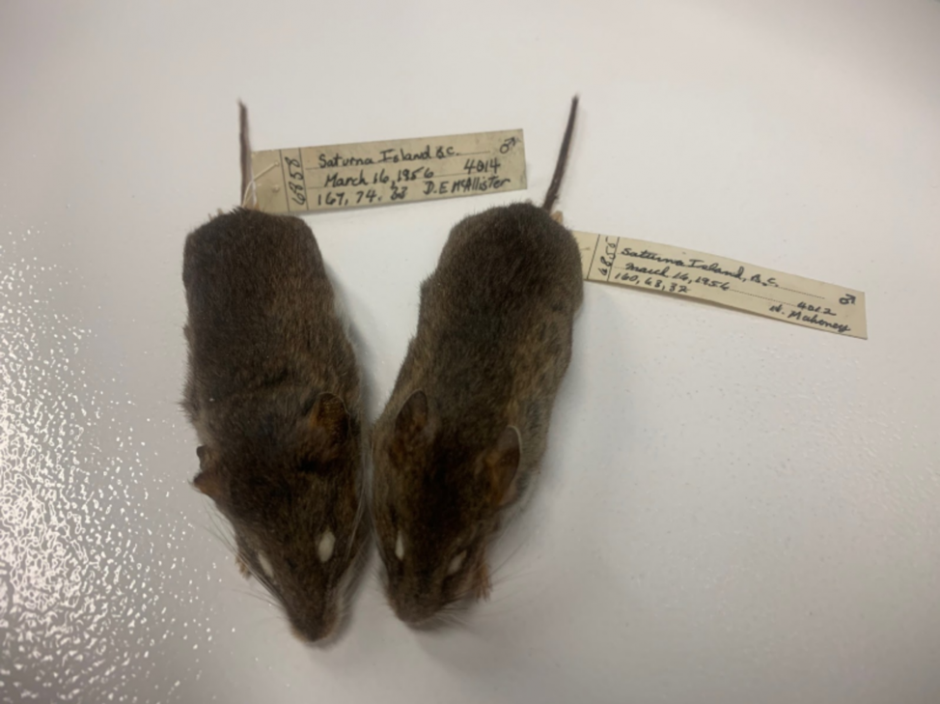
M006855 & M006858: Neither Nancy or Don McAllister studied rodents but this did not deter them from donating specimens unrelated to their study species (grebes and fish). They each collected one of these North American Deermouse on Saturna Island on March 16, 1956.
Researched and written by Ildiko Szabo

Edwin Earl Sechrist, 1890-1964
Contributor Snapshot
Sechrist was an amateur naturalist who collected eggs principally in Southern California plus many of the pacific islands of the coast of Mexico. He was active in the Cooper Ornithological Society throughout his lifetime and his egg collections have been deposited in many museums including the Yale Peabody Museum, the Chicago Academy of Science and the San Bernardino County Museum.
Contribution to the Cowan Tetrapod Collection
The Cowan Tetrapod Collection has 7 egg clutches collected in California by Sechrist. The oldest is the Hooded Oriole clutch collect on May 9, 1911.
Researched and written by: Ildiko Szabo
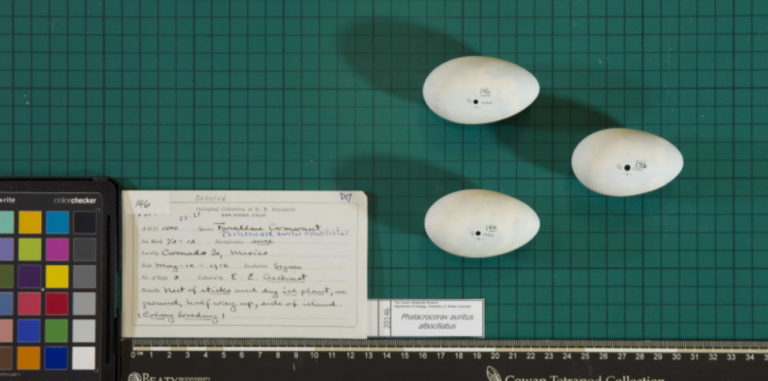
B0020146: Farallon Cormorant is a name rarely used nowadays for the Double-crested Cormorant subspecies Phalacrocorax auritus albociliatus (Ridgway 1884). This is the resident subspecies we see in British Columbia. They are named after the Farallon Islands, a small group of craggy islands and sea stacks off the coast of San Francisco, California. These hazardous cliffs are perfect for nesting cormorants and are sometimes referred to as the Devil’s Teeth Islands. On May 12, 1912, Sechrist collected these three Farallon Cormorant eggs halfway up a seaside slope on Coranoda Island, Mexico; a much more hospitable place.

Dr. Francis Hollis (Bud) Fay, 1927-1994. Simultaneously a Researcher at the Institute of Marine Science and a Researcher at the Institute of Arctic Biology, University of Alaska, Fairbanks; member of the steering-planning committee, Marine Mammal Project, US-USSR Agreement on Environmental Projection.
This photo was taken in June 1979 by Dr. Brendan P. Kelly on Punuk, Island in the northern Bering Sea while investigating a mass walrus mortality.
Contributor Snapshot
Author of numerous scientific papers and books, Francis (Bud) Fay is best known for his 1982 monograph: Ecology and biology of the Pacific Walrus, Odobenus rosmarus divergens. Fay’s editing skills and thoroughness were legendary. In order to read all the literature available on Pacific Walruses, he and his wife learned Russian. As a team, they translated over 120 scientific articles into English. His Arctic publications were not restricted to walruses, Fay also published on Arctic foxes, small mammals and birds.
Fay relied heavily on local knowledge and especially on the Siberian Yupik guides who helped him and with whom he lived. Many of his publications include folklore and local knowledge. The existence of rogue carnivorous walruses who hunt, kill and consume seals and whales is the stuff of legends. Fay investigated these stories and the occurrence of these rare beasts from the Bering Sea to the waters around Greenland. He proved scientifically that they do in fact exist. Fay’s findings suggest that orphaned calves lacking a mother to teach them how to extract mollusks and other invertebrates from the ocean floor are more likely to hunt seals.
At the end of his PhD fieldwork on St. Lawrence Island, Fay donated his beloved coat, a Yupik parka to the UBC Museum of Anthropology (A2.486) which he had worn for 4 years. The brown ovals in this parka are belly skins of Double-breasted Cormorants, a species commonly seen around Vancouver.
Two obituaries have been published about this remarkable man: Link 1 Link 2

Photographer unknown. Image taken circa 1960 off of Round Island.
Dr. Fay is the one closest to the camera.
Contribution to the Cowan Tetrapod Collection
In 1955, Francis H. Fay completed his PhD thesis: The Pacific Walrus (Odobenus rosmarus divergens): special ecology, life history, and population. Previously, he had earned his Masters at the University of Massachusetts for his work on the ecology of Cottontail Rabbits. Having become enamoured by American Pikas while working as an Oregon fire lookout, he headed to UBC to do graduate work on the species. His thesis advisor, Dr. Ian McTaggart-Cowan, had other ideas. Shortly after arriving in Vancouver, Fay was shipped out on a military vessel to study the walruses of St. Lawrence Island, an Alaskan Island in the Bering Sea closer to Russia than the USA.
The following year (1953), he returned to St. Lawrence Island for seven months to collect specimens and data on walruses, terrestrial mammals, and birds with Barbara A. Fay whom he had recently married.
The Fays contributed widely to the Beaty Biodiversity Museum: 22 fish, 90 plants, 71 birds and 65 mammals. The BBM is much indebted to this couple for being the first, or one of the first, contributors of specimens from the Bering Sea to so many of our museum collections. Fay also contributed birds and mammals to other museums. The USNM (Smithsonian) has 16 specimens, the University of Alaska has ~39, Los Angeles County Museum has one, and there are probably many other Fay specimens lurking in other tetrapod and herbarium collections.
Fay personally contributed 62 mammal specimens with the majority being Pacific Walrus skulls in addition to Bearded, Ringed, and Ribbon Seals, a Steller Sea Lion, Arctic Foxes, and Tundra Voles.

Photo credit: Ildiko Szabo
Chris Stinson, BBM Mammalian Specialist holding the skull of a suspected carnivorous Pacific Walrus (M004273). Typically, walrus tusks are subject to abrasion and damage incurred while digging for food in muddy substrates. Since they do not use this feeding behaviour, the tusks of seal hunting walruses are longer than those found on an individual of a similar age and sex. Consuming seal and whale blubber stains their ivory tusks a yellowish hue. Local knowledge has known for millennia that the liver of these rogue beasts is toxic, as is the liver of Polar Bears. Their toxicity is due to elevated levels of vitamin-A obtained from consuming so much seal fat. Read more about carnivorous walruses here.
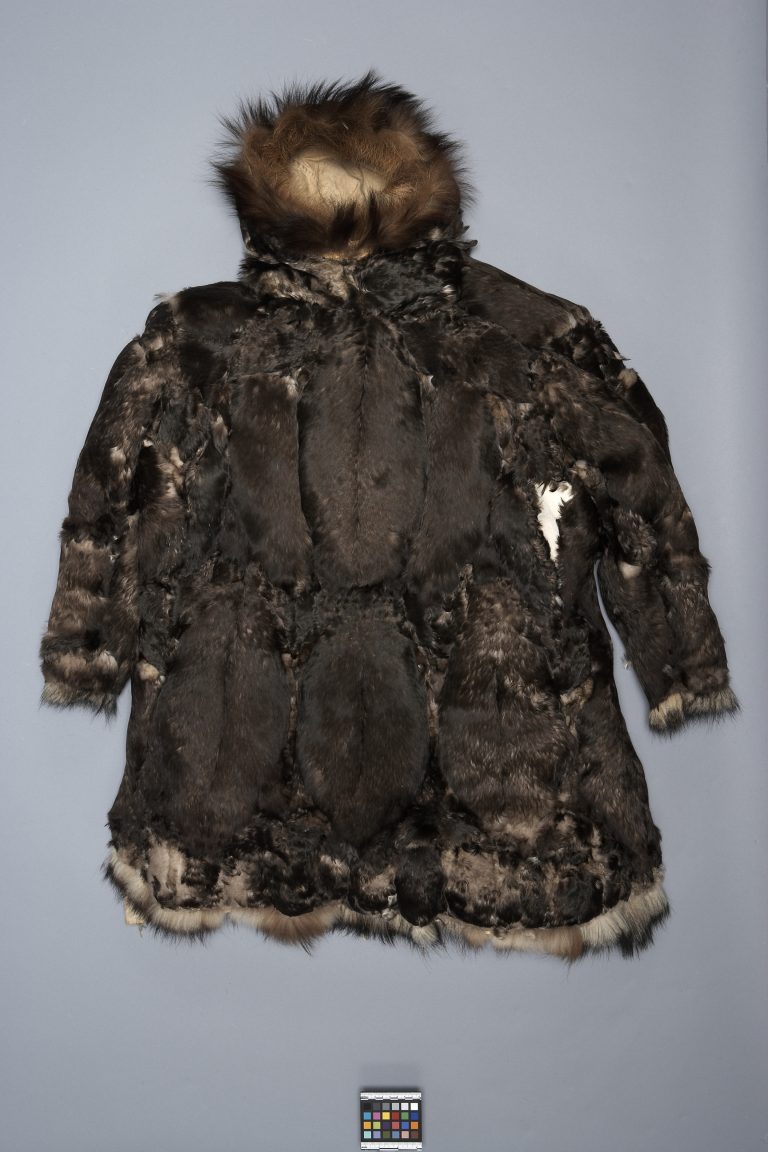
Photo credit: Tim Bonham, Copyright UBC MOA.

Photo credit: Tim Bonham, Copyright UBC MOA.
Cultural object A2.486 housed at UBC Museum of Anthropology is the Siberian Yupik parka worn by Francis H. Fay while conducting his PhD fieldwork. The outer layer has a minimum of 20 Double-crested Cormorant (Phalacrocorax auritus) belly skins with a wolverine ruff around the hood and the bottom of the parka. More information on MOA A2.486 is available here.

At left, Ildiko Szabo BBM bird specialist discusses with Susan Rowley, MOA Arctic Curator the fabrication of the Siberian Yupik parka (MOA A2.486) donated by Francis (Bud) Fay. Observing are BBM avian Work-Learn students Finola Fogarty and Quinn McCallum.
Photo credits: Kaitlin Chamberlain
As per the MOA records for A2.486 parka, bird skins were used on St. Lawrence Island for clothing because of the absence of caribou. The feathers on the hood point up enabling the wearer to flick out the snow more easily. Wolverine is used for the ruff around the hood so the frost caused by breathing can be brushed off more easily because the hair is long and uneven. While mass-produced clothing from the south is now commonly worn, the making of skin clothing is being revived in the Arctic. Read more!
Researched and written by Ildiko Szabo
Contributor Snapshot
For his groundbreaking research on island populations, Frank S. Tompa was awarded a UBC PhD and a diploma from the University of Science, Szeged, Hungary. In 1960, Tompa initiated the now-famous Mandarte Island Song Sparrow study. Recently the Mandarte study of individually marked sparrows celebrated its 60th anniversary. Mandarte Sparrows have been extensively studied by UBC students and professors. The list of researchers that have participated in this project reads like a celebrity column and includes Peter and Rosemary Grant whom later replicated many aspects of the Mandarte Island study on Daphne Major Island (Ecuador) with Galapagos finches.
Later in Victoria, Tompa worked for many years in Carnivore Management for the BC Ministry of the Environment.
Contribution to the Cowan Tetrapod Collection
There are 25 Tompa avian skins in the collection. The 6 Mandarte Island skins are shorebirds (5 Black Turnstones and a Surfbird). Tompa was a master preparator. Two of his skins (a Black Turnstone from Mandarte Island and a Townsend’s Solitaire from Loon Lake) were included in a set of 13 birds specimens traded with the Naturhistoriches Museum, Vienna.

Today, UBC Arcese Lab members are still conducting sparrow research on Mandarte Island. This photograph was taken by a member of the lab in 1964 (Digitizing Sponsor: Harvard University, Museum of Comparative Zoology, Ernst Mayr Library).

Title: The Canadian field-naturalist Identifier: canadianfieldnat1964otta (find matches) Year: 1964 (1960s) Authors: Ottawa Field-Naturalists’ Club – Wikimedia Commons
Researched and written by Ildiko Szabo
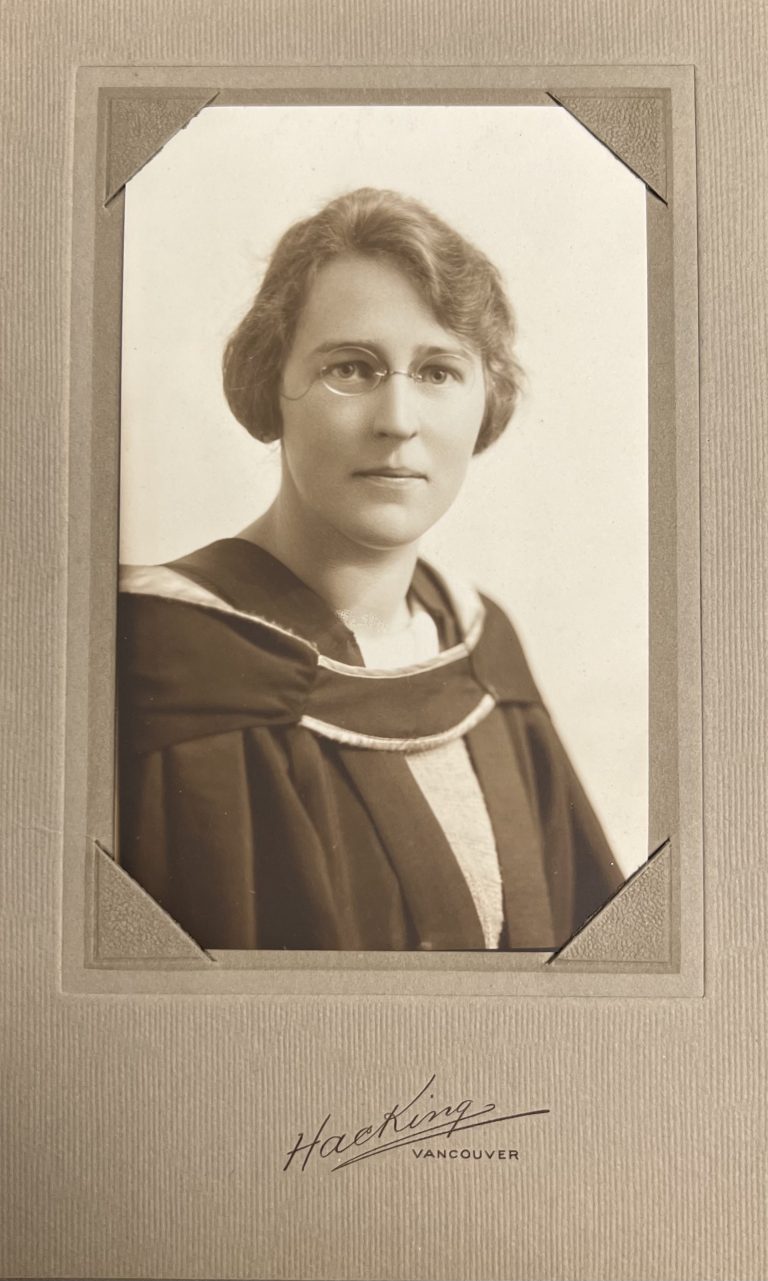
Dr. Gertrude May Smith, 1902-1986. UBC BA Biology 1923; UBC MA Biology 1926, UCal Berkeley PhD 1934. (Photo credit: 1926 Graduation image from UBC archives library.ubc.ca/archives/first100
Contributor Snapshot
As the first woman to join UBC’s Faculty of Science when she was hired as an Assistant Professor in 1930, Dr. Gertrude May Smith was a trailblazer. Her association with UBC spanned the 1920s and 1930s. She completed a BA in Biology in 1923 and then worked as a Lab Instructor, 1924-26, while she studied toward her MA. As a master’s student, Smith observed and collected specimens of the salamander, Rough-skinned Newt, from Beaver Lake in Stanley Park, the UBC Endowment Lands wetlands, and a pond that no longer exists near 16th Avenue and Arbutus Street.
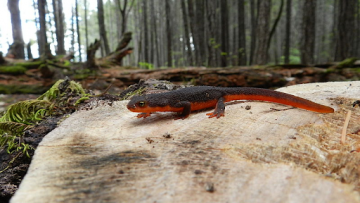
Photo credit: DSHil, Rough-skinned Newt taken in Josephine County, Oregon.
Smith opened her masters thesis, “The Detailed Anatomy of Triturus Torosus” (available on UBC CiRCLE), with the following explanation and synthesis:
This investigation was undertaken, on the advice of Dr. Fraser [Smith’s supervisor], because of its interest from an evolutionary standpoint. As the investigation has shown, this form [Rough-skinned Newt] is much more nearly in the direct line of descent of higher vertebrates than is the frog, which, in comparison, is very highly specialized.
On graduation in 1926, the Department of Biology hired Smith as an Instructor, a position that she held until she set off for the University of California (Berkeley) in 1928 to pursue a Ph.D., a degree that UBC did not offer at the time. As a doctoral student, Smith continued her work on salamanders and completed a dissertation on “The Nasal Region and Organ of Jacobson in Some American Salamanders” in 1934. While at Berkeley, Smith was invited to join two honorary American scientific societies: Phi Sigma (biological) and Sigma Xi (general science). She also taught courses in Zoology as a Teaching Fellow.

Gertrude M. Smith, circa 1933, in a labcoat inspecting specimens with students in the UBC Zoology Department.
In 1930, before she had completed her Ph.D., UBC’s Faculty of Science hired Smith as an Assistant Professor and its first female faculty member. At UBC, Smith continued her work on salamanders, including a study of the decimation of Rough-skinned newts (1939-40) as they migrated through Stanley Park to Beaver Lake across the new road to the Lions Gate Bridge (now the “Stanley Park Causeway”). Her publications include studies of: four different species of clams, the interactions of phytoplankton and clams, the distribution of decapod crustations in Saanich Inlet, a detailed anatomy of one salamander species, and the comparative anatomy of the nasal region of six salamander species. In this last study, her Ph.D. dissertation, Smith drew connections between the structure of the nasal apparatus of the species and its habitat (aquatic, partly-aquatic/partly-terrestrial, or terrestrial).
While an Assistant Professor (1930-1940), Smith taught Zoology 1 (General Morphology), Zoology 2 (Comparative Anatomy of Vertebrates), Zoology 3, (Comparative Anatomy of Invertebrates), and Zoology 6 (Embryology).

Dr. Gertrude M. Smith, seated, with students in her 1931 lab. The models and jars suggest this was a comparative morphology lab. The student in the back row on the right is Ian McTaggart Cowan. Like Dr. Smith, he would go on to Berkley to obtain a PhD and return to UBC to teach. Dr. Cowan is the founder of the Cowan Tetrapod Collection.
In 1985, Smith (then Gertrude Watney) offered the following recollections of her experience as a woman on faculty:
. . . there were very few women, in any field, on the faculty, and none in science, as I remember. There were several laboratory instructors and junior assistants, but no professors. However, I was not aware of doing anything unusual at that time. My colleagues in the Arts departments worked, as I did, together with the men on the faculty without any suggestion that we were out of place. We were not as conscious of “women’s rights” and “women’s lib” as many of women are today, and I think that, in some ways, we were happier for it, and perhaps accomplished as much.
(Quote source: library.ubc.ca)
The UBC Zoology departmental history describes Smith as one of “The Pioneers”.

UBC Department of Zoology History, zoology.ubc.ca/about/department-history
However, Smith’s time at UBC ended abruptly and without explanation. When the Zoology Department Head, McLean Fraser, retired in 1939, the Zoology Department and the Faculty of Science did not renew Smith’s contract as Assistant Professor. She only discovered that her position had been terminated when she went to the bursar’s office to collect her monthly pay cheque and there wasn’t one. Nobody ever told her why her appointment had not been renewed (MJ Harris, pers. comm.).
Later in life, Smith speculated about the reasons why her contract was not renewed. She had married Reverend Douglas P. Watney, Professor of Theology in the Anglican Theological College at UBC, in 1937 and it was not uncommon for married women to lose their jobs to preserve them for men during the Great Depression. It may have been that the Department of Zoology was changing its focus, shifting towards a study of ecology instead of comparative anatomy; the same year her appointment was not renewed, the Zoology Department hired an ecologist, Ian McTaggart Cowan. It may have been that Smith had not yet published the material in her PhD dissertation. In 1938, the editor of the Journal of Morphology returned her manuscript, saying that with so many illustrations (approximately 60) it was too expensive for that journal (or likely any other Wistar journal) to publish. Whatever the reason, Smith was never told, and the protections of tenure did not yet exist (MJ Harris, pers.comm.).
Although Smith would not hold another academic position, she never lost her fascination with the natural world. Through her continuing curiosity and enthusiasm, she inspired her daughter, Muriel J. Harris (nee Watney), to pursue a career in zoology. Harris joined UBC’s Department of Medical Genetics as a Research Associate in 1978 and retired as an Associate Professor Emerita in 2006. One of Smith’s grandsons, Colin Harris, completed a PhD at UBC in Biochemistry in 1998 and another, Douglas Harris, is currently a Professor in UBC’s Peter A. Allard School of Law, extending the family’s connection with UBC faculty to a third generation.
Additional material on Gertrude Watney (nee Smith), including her UBC Zoology lecture and laboratory notes, is available in UBC Archives. A published obituary appears in a 1986 UBC Faculty Women’s Association newsletter.
Contribution to the Cowan Tetrapod Collection
Gertrude M. Smith contributed 107 specimens between 1929 and 1931 from the lower mainland of BC and Alameda County, California, that are now part of the Cowan Tetrapod Collection. Eighty-six of them are of the subject of her master’s thesis, the Rough-skinned Newt.
Smith used a manual typewriter for all her academic writing. If she made a typo or wanted to add information or change the wording, the entire page had to be retyped. Also, she had no digital tools to produce her elegant and detailed diagrams. The images below, from Smith’s Master’s thesis, are her drawings of a Rough-skinned Newt’s heart and its associated major veins and arteries (Plate V), and of the arteries in its legs (Figures 17 and 18).

Smith, “The Detailed Anatomy of Triturus Torosus,” UBC Master’s thesis, page 68.


Smith, “The Detailed Anatomy of Triturus Torosus,” UBC Master’s thesis, page 72.
Smith also collected and donated California Slender Salamanders, Arboreal Salamanders, Pacific Tree Frogs, and Columbia Spotted frog specimens. These fluid specimens were likely part of the foundational collection when the UBC Vertebrate Museum (now called the Cowan Tetrapod Collection or CTC) opened in 1943.
Specimen H000437 is one of a pair of Columbia Spotted Frogs collected in 1926 by Gertrude M. Smith from near New Denver, BC, where she was born and lived until she came to UBC in 1919. The CTC has just under 50 specimens of this frog; Smith’s specimens are the oldest. (Photo Credit: Nola Moray)

Specimen H000437 is one of a pair of Columbia Spotted Frogs collected in 1926 by Gertrude M. Smith from near New Denver, BC, where she was born and lived until she came to UBC in 1919. The CTC has just under 50 specimens of this frog; Smith’s specimens are the oldest. (Photo Credit: Nola Moray)
Researched and written by Ildiko Szabo, Muriel Harris (daughter of G. M. Smith) and Douglas Harris (grandson of G.M. Smith)

H. A. Hochbaum, 1911-1988. Founding Director, Delta Waterfowl Foundation, Manitoba.
Contributor Snapshot
H. Albert (Al) Hochbaum excelled as an artist, a writer, and an ornithologist. The most famous of the three book he authored and illustrated is: The Canvasback on a Prairie Marsh. It won a Wildlife Society Award, one of many writing awards Hochbaum received. His writing is described as poetic observation of ecological landscapes. Hochbaum, a student of Aldo Leopold, was the Founding Director of what is now the Delta Waterfowl Foundation, Manitoba. He held this post for 32 years. For part of this time, he was also an Honorary Professor at the University of Manitoba.
Contribution to the Cowan Tetrapod Collection
Hochbaum prepared and shipped 4 ducklings (Northern Shoveler, Gadwall, Pintail, and Blue-winged Teal) to the CTC while he was the Director of the Delta Waterfowl Research Station, Manitoba.
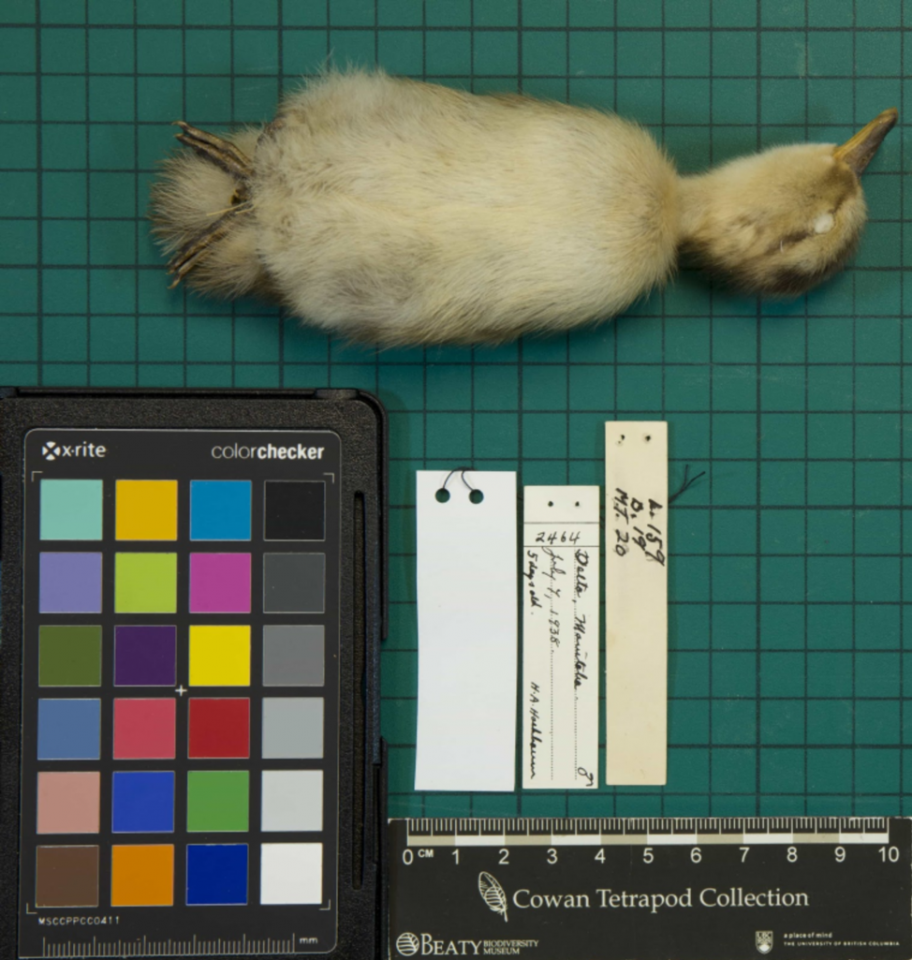
B002464: Hochbaum prepared this 5 day old captive reared Gadwall duckling. It died on July 7, 1938 near Delta, Manitoba.
Researched and written by Ailsa McFadyen-Mungall
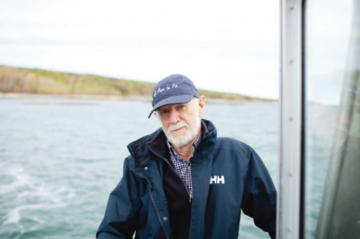
Dr. Jean H. Bedard, 1938-2019. Founder of DuvetNor, Quebec.
Contributor Snapshot
Originally from the Rivière-du-Loup area, Jean H. Bédard returned to Quebec after finishing graduate work at UBC. With funding from the University of Laval and other sources, he conducted St. Laurence River waterfowl research. Bédard has over 30 publications to his credit plus in 1972 he released a CD: Guide Sonore des Oiseaux du Québec. Bédard is best known as the founder of Duvetnor. In 1979 in order to protect eider duck nests from relentless harvesting, Bédard and some biologist friends obtained eiderdown collection rights to several private and public St. Lawrence Islands. Using the profits, their NGO Duvetnor started purchasing these seabird breeding islands. Today the society owns 9 islands in the upper St. Lawrence Estuary. As well as ongoing ecological research, Duvetnor is known for its ecotourism and educational programs. On Pot á l’Eau-de-Vie Island, Duvetnor converted the abandoned lighthouse into a spectacular 3 room inn plus a visitors centre. Check out this interview with Bédard titled: “A Rare Bird“.
Contribution to the Cowan Tetrapod Collection
Ecological Segregation among plankton-feeding Alcidae (Aethia and Cyclorrhynchus) is the title of Jean H. Bédard’s 1967 PhD dissertation. All 47 skins deposited at the CTC by Bédard are from Alaska (St Lawrence Island or the Nome Census Area). 28 skins and 2 skeletons are alcids, his study species: Crested Auklet, Parakeet Auklet and Least Auklet.

B011868: The flip side of this King Eider’s label states it was collected on June 17th, 1964 near Gambell, Alaska by J. Bedard.
Researched and written by Ildiko Szabo

Joyce (Lanko) Elliott, 1938 – 2001. UBC graduate student. Lecturer at UBC’s Department of Zoology 1963-64. Businesswoman. Elliott was still a student when a Vancouver Sun photographer took this image during a 1959 UBC Open House.
Contributor Snapshot
Born in 1938, Joyce Laurian Lanko picked up an interest in science at an early age while exploring her hometown of Winnipeg. For university, she elected to venture west and attend UBC. First, she did a Bachelor’s and then went on to complete a Masters Degree. Both Lanko and her future husband Arthur Kevin Elliott were graduate students of the founder of the Cowan Tetrapod Collection, Dr. Ian McTaggart-Cowan.
After teaching for a year (Lecturer in Zoology 1963-64), Lanko enrolled in a Ph.D. program at Monash University (Melbourne) to study the biogeographical connections between Australian and South American marsupials by looking at hair scales morphology. But, having met her husband and subsequently starting a family, Joyce Lanko (now Joyce Elliott) was unable to complete her studies. A common occurrence in the 1960’s when graduate studies were deemed incompatible for married women and especially for women with small children. This resulted in many women in STEM “dropping-out”. Motherhood ended Joyce’s academic career but didn’t stop Joyce from having a pioneering role in the discipline she loved: the study of small animals.
In 1965, Joyce’s husband Kevin invented a folding aluminum small animal trap that was so cutting edge that 50+ years later, the ‘Elliott Trap’ is still used around the world to capture terrestrial vertebrates for research or relocating purposes. This husband and wife team founded Elliott Scientific Equipment based out of Upwey, Australia which manufactured and shipped their traps around the globe. Joyce helped advise their clients on trapping methods plus answered biodiversity and animal behaviour questions.
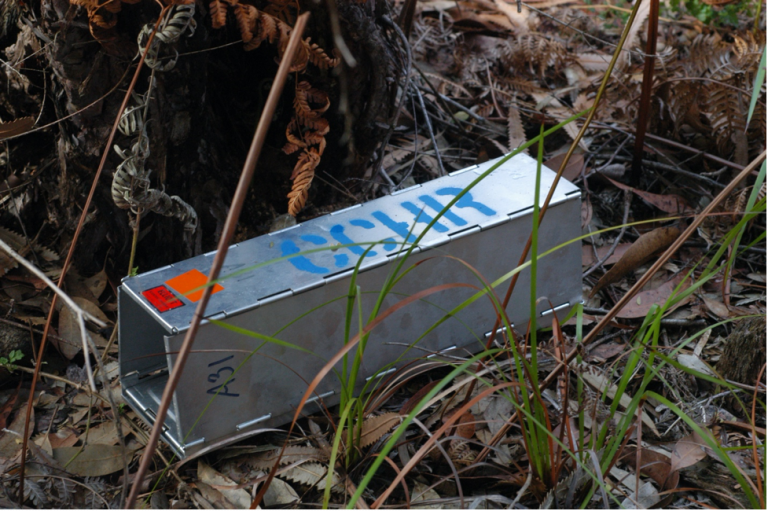
Photo Credits: Doug Beckers (Wiki Commons 2.0)
Contribution to the Cowan Tetrapod Collection
For her Masters, Joyce Lanko examined two species of Peromyscus (Deer Mice) in Southern Ontario. As part of her thesis, Lanko devised a method for separating Peromyscus leucopus noveboracensis from Peromyscus maniculatus gracilis based on body measurements.
While working on her thesis, Joyce Elliot Lanko contributed 21 specimens to the Cowan Tetrapod Collection. Not surprising, Lanko’s mammal donations are almost exclusively Rodentia (order containing voles, chipmunks, and mice). Three from Ontario and the rest from British Columbia. Her donation of a Cinereus Shrew is her only mammal specimen outside of this group, shrews belonging to the order Soricomorpha.
Joyce also had a keen interest in reptiles and amphibians. She added eight herpetology specimens to the collection including two Garter Snakes and a Wandering Salamander, one of the ‘lungless’ salamanders.

This Wandering Salamander, “Aneides vagrans”, was collected by Joyce Lanko.
Specimen No.: H001478. Photo credit: Ildiko Szabo
Researched and written by: Ildiko Szabo and Ailsa McFadyen-Mungall
Contributor Snapshot
Leo Jobin was born in a trap-line tent in Arctic Quebec. In 1929, he was hired as a BC Game Warden initially working in the interior of BC. From 1940 until he retired in 1955, he worked out of Williams Lake. In total, Jobin published 19 papers. On Sept 8, 1946 Jobin photographed the first known sighting of a Barred Owl in BC, a species that was at the time rapidly expanding its western range across North America. Jobin is credited with collecting the first Canadian record of a European Kestrel on December 10, 1946 at Alkai Lake (RBCM No. 15934). The Canadian Museum of Nature houses ~1,013 avian specimens collected by Jobin and the Royal BC Museum has ~425 of his avian specimens.
Contribution to the Cowan Tetrapod Collection
The Cowan Tetrapod Collection has 14 avian specimens and 56 mammal specimens procured for the museum by Leo Jobin. All these specimens were obtained while he was a Game Warden in the Cariboo District.

M000878: Joban donated this American Martin Skull in 1945. Also include this years gift to the museum was a Hawk Owl, plus skulls of Lynx, Bobcat, Fisher, otter, beaver, fox, mink, marten, wolf, and badger.
Researched and written by Ildiko Szabo
Contributor Snapshot
When Mary F. Jackson finished her Masters in 1952, the UBC Zoology Department had yet to granted a female a PhD. This did not happen for another 11 years. Jackson taught at UBC from 1958 until 1990. Though only having a Masters degree, she was promoted to Assistant Professor in 1966.
Contribution to the Cowan Tetrapod Collection
Mary Fairfield Jackson specimen legacy is 95 mammals and birds specimens. The majority are extremely small mammals reflecting her thesis topic: Variation in an Isolated Population of Shrews of the Vagrans-obscurus Group. While teaching at UBC she conducted many studies on waterfowl resulting in 23 of her avain donations being goldeneyes and other ducks.

B004472: “On May 13, 1954, a drake goldeneye in full nuptial plumage was picked up in a moribund condition on Westwick Lake, 12 miles south of Williams Lake, BC. The specimen is intermediate between Bucephala islandica and B. clangula and is probably a hybrid. It was prepared as a study skin and is now N. 4472 in the collection of the Museum of Zoology, University of BC. The trachea was preserved with the specimen.” Extract from Mary. F. Jackson. 1959. A hybrid between Barrow’s and Common Goldeneyes. The Auk 76(1): 92-94.
Researched and written by Ildiko Szabo

Dr. Milkós D. F. Udvardy, 1919-1998. UBC Assistant Professor (1952-1966); worked at other universities before and after his UBC appointment.
Contributor Snapshot
Dr. Milkós D. F. (Nick) Udvardy was born and attended university in Debrecen, Hungary. His PhD was on the avian ecology of the Hungarian Plains. As well as 100’s of avian museum skins which he prepared himself, Udvardy left a legacy of 191 published papers and 8 books. He is best known for his textbook: Dynamic Zoogeography (1969). Speaking 6 languages and reading 5 others, Udvardy linked UBC ornithologist with colleagues from around the world. Udvardy assisted the 210 students and 30 faculty and their families from Sopron University’s School of Forestry to flee the 1956 Hungarian Revolution and migrate to Canada, many of whom came to UBC. After leaving UBC, Dr. Udvardy worked as a Professor of Biological Sciences at California State University, Sacramento from 1967 until his retirement in 1991. Both at UBC and at the many other universities he worked at, Udvardy was an inspiring mentor and grad student supervisor for a myriad of students.
Contribution to the Cowan Tetrapod Collection
From 1952-1966 Udvardy worked as a UBC Zoology Assistant Professor lecturing on comparative anatomy and ornithology. During the 1958-59 academic year, Udvardy was a visiting professor at the University of Hawaii. Out of the 316 Udvardy specimens housed at the Cowan Tetrapod Collection, 133 birds were prepared by Udvardy while in Hawaii. They include Hawaiian endemics honeycreepers. The Cowan Tetrapod Collection is very fortunate that Udvardy contributed a pair of Laysan Ducks and a few Laysan Finches; species which are rarely found in small museum collections.
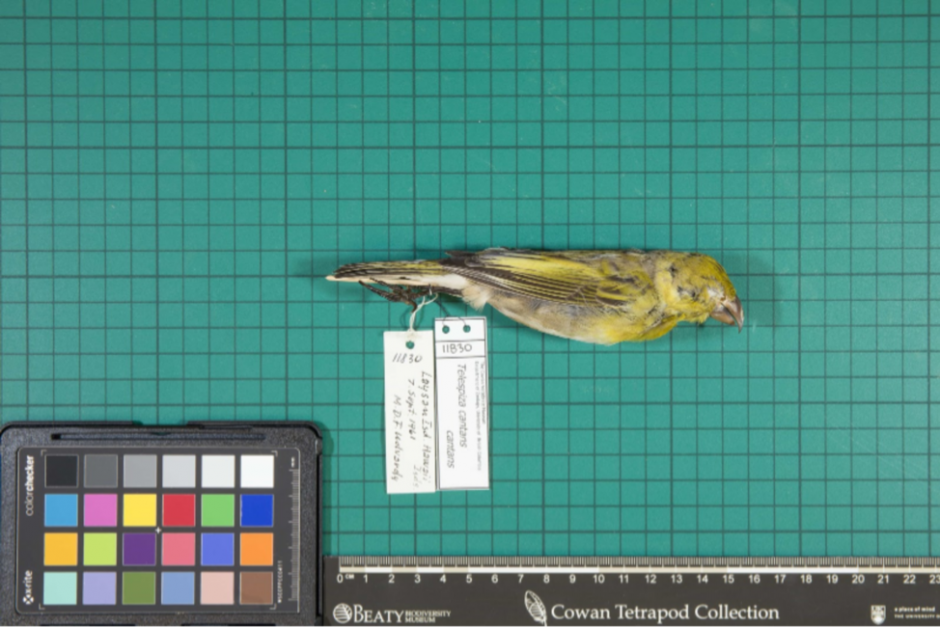
B011830: BirdLife International states that the breeding and resident area of Laysan Finches is 4 square kilometers on the small northwestern Hawaiian island of Kauō, formerly called Laysan Island. The finch populations fluctuate between 7,000 to 1,500 birds depending on when the last tropical storm hit the island. This endemic is a large billed honeycreeper; a generalist feeding on insects, albatross and other seabird eggs, carrion, as well as seeds and fruits.
Researched and written by Ildiko Szabo

Mrs. T. L. Thacker, 1871-1953, citizen scientist, farmer, pioneer homesteader and mother of 4 children
Contributor Snapshot
Mrs. T. L. Thacker (née Beatrice Muriel May Sprague) was a keen Natural History observer keeping records of flora and fauna as well as weather. She was born in England and grown up in Scotland. Beatrice Sprague’s father made it a condition of marriage that she travel to Hope, BC to check out the town and the homestead her fiance’s, T. Lindsay Thacker, was proposing as their permanent home. Beatrice’s journals from this 1906 journey are full of the scientific and common names of all the flora and fauna she was seeing as she and her companion (her fiancé’s sister) travelled across Canada by train and during their travels in southern BC. Both with her husband or solo, Mrs. T. L. Thacker published many articles in peer reviewed journals. This couple deposited many specimens at what is now called the Royal BC Museum and also to the UBC Museum of Zoology after it was founded in 1943.
Contribution to the Cowan Tetrapod Collection
Beatrice M. M. Thacker, who was better known as Mrs. T. L. Thacker, donated an eclectic variety of specimens to the CTC. They include a Rubber Boa, several Ermine with either winter white or summer brown colouration, hawks, owls and other birds. Mrs. T. L. Thacker and her husband were friends of Kenneth Racey, and Ian McTaggart-Cowan. They were members of the same natural history societies. At some of these meetings, Mrs. T. L Thacker played a leading role.
Photograph courtesy of Beatrice M. M. Sprague’s granddaughter, Rene MacDonald of Quesnel, BC.

B003519: The label closest to the tail of this Cooper’s Hawk states: received in flesh, Collector Mrs. Thacker. In 1935, this bird was given to and prepared by Kenneth Racey who later donated it to the CTC.
Researched and written by Laura N. Webb and Ildiko Szabo
Contributor Snapshot
Nancy Mahoney McAllister (nėe Nancy Ann Mahoney), first female UBC Zoology PhD graduate (1963), University of Ottawa Professor of Biology. Nancy Mahoney McAllister was the first female to be granted a Ph.D by UBC Zoology. She published her thesis material on Grebe behaviour in the prestigious Wilson Journal of Ornithology and The Auk. McAllister pursued diverse avian topics while a Professor at the University of Ottawa. As a Yoquot Project team member, she identifying and publishing on the avian remains found at this First Nations archeological site on Nootka Island, BC. During her UBC studies, she meet her husband who later became the Curator of Fishes at the Canadian Museum of Nature. Their busy life together include raising five children.
Contribution to the Cowan Tetrapod Collection
McAllister’s supervisor for both her Masters and her Doctorate was the founder of the Cowan Tetrapod Collection, Ian McTaggart Cowan. Nancy contribution to the collection is small: 1 North American Deermouse and 1 previously banded Brewer’s Sparrow.
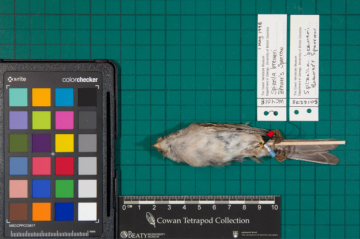

B016278: McAllister recognized the importance of salvaging this banded Brewer’s Sparrow when she found it at Kilpoola Lake in the BC Okanagan. Banded bird specimens are sometimes called double databirds. Information is gathered the day they are banded and again when they are recaptured or found dead.
Researched and written by Ildiko Szabo
Contributor Snapshot

Dr. Rudy Boonstra (1949- ), Professor, University of Toronto Scarborough, Department of Biological Sciences
For 50 years, Dr. Rudy Boonstra led undergraduates, graduate students, and research groups at the University of Toronto Scarborough. Boonstra, his students, and collaborators have conducted fieldwork in Ontario, most of the provinces of western Canada, the boreal forest of SW Yukon at the Arctic Institute Base beside Kluane Lake, and the Arctic coast of the NWT at an old DEW line site (Pearce Point). His research interests are wide, focusing on the adaptations mammals and birds have to their natural environment. With students and collaborators, he has tackled population regulation and limitation, the roles of social processes and predation, stress physiology and brain mechanisms, maternal effects, and epigenetics. Either directly or with collaborators Boonstra has worked on over 35 mammal species, 2 bird species, and 1 reptile. He has published over 260 papers, with key ones in each of the above areas. Among them are review papers and many technique papers that have advanced our study of animals in their natural habitat.
Boonstra is beloved as a mentor and a teacher. Many UTSC undergrads first met Professor Boonstra when enrolled in one of his courses: Fundamentals of Ecology, Advanced Population Ecology, Environmental Biology, or the Biological Consequences of Climate Change.
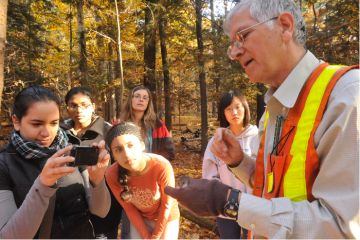
Rudy Boonstra teaching undergrads at the University of Toronto. (Photo credit: Ken Jones)
Over the years Boonstra has supervised or co-supervised 24 M.Sc.’s and 20 Ph.D.’s, and 12 Post-doctoral Fellows. Collaborations with colleagues at all levels – their guidance and criticisms were critical in his development and thinking, especially his Ph.D. supervisor Dennis Chitty, and mentor Charles Krebs. The latter has been key over his entire career. With his family, Boonstra spent a sabbatical year in Canberra, Australia working on the causes of house mouse plagues in southeastern Australia. While there he learned a critical technique under the guidance of Dr. Lyn Hinds: How to measure hormone levels in plasma and this was key to his future research projects on stress, reproduction, and life histories in mammals and birds. Boonstra also spent a year in Oslo, Norway at the Centre for Advanced Studies working with a team studying the causes of population cycles in mammals. Chance meetings have resulted in collaborations that inspired different research directions. Martin Wojtowicz (UofT, Dept Physiology) stimulated his interest in neurogenesis (formation of new neurons in the adult brain) and how studying this in wild mammals could help our understanding of how this occurs. Kiran Soma (UBC, Dept Psychology) stimulated his interest in the hormonal basis for territoriality during the non-breeding season.
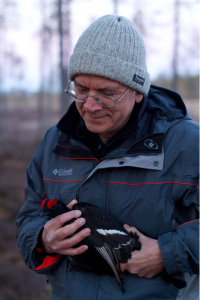
Rudy Boonstra holding a Black Grouse while assisting colleagues studying their lekking behavior, April 2013 Norway. (Photo credit: Knut)
Check out the 36-minute mark of this CBC Nature of Things episode called: Remarkable Rabbits. Dr. Rudy Boonstra’s work on Snowshoe Hare / Canada Lynx interactions is highlighted with a segment on how female hares pass on the “Ghosts of Predators Past” information to their young.

Snowshoe hare in the Yukon surrounded by its food (willow) and its protective snowy background. (Photo credit: Rudy Boonstra)
Boonstra first learned how to prepare museum specimens while he was studying at UBC. He was a teaching assistant for one of J. Mary Taylor’s mammalogy courses (Curator, Director of the Cowan Tetrapod Collection 1971-1982). His interest in museum and museum collections did not end there. Over the years Boonstra has prepared and donated 97 specimens to the Royal Ontario Museum. The majority of these specimens are Northern Collared Lemmings.
Contribution to the Cowan Tetrapod Collection
In 1976, Rudy Boonstra defended his PhD thesis titled: Experimental studies of the population processes in the vole Microtus Townsendii. The different chapters in Boonstra’s thesis assess the effects of survival and dispersal during population declines, juvenile survival, reliability of trapping methods, and the impact of predation. They resulted in 5 papers. Side projects and collaborations resulted in an additional 6 vole papers.
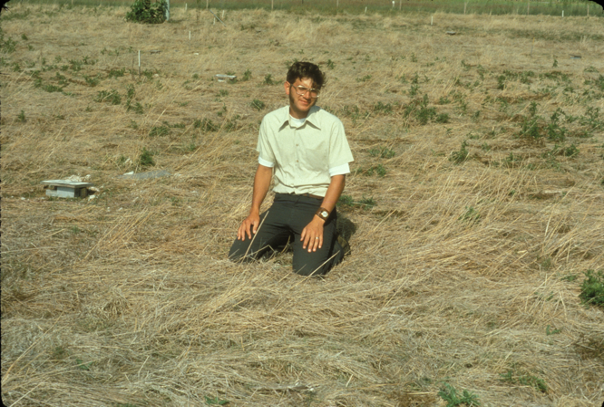
Rudy Boonstra at his PhD study site on Westham Island in 1975. The experiment prevented voles from dispersing away from their home range by fencing in a large area, which markedly reduced that mortality, but resulted in overpopulation and severe overgrazing. (Photo credit: Charles Krebs)
When first applying to Graduate School, Boonstra interests were in a different direction:
“In my last 2 summers when I was an undergrad at U. Calgary, I worked on wolves for the Canadian Wildlife Service in northern Jasper National Park. I then approached Ian McTaggart Cowan to do a PhD on wolves, but he declined. He had another PhD working on them. I then switched to the opposite end of the size spectrum – the Townsend’s vole – and approached Dennis Chitty. It was the best decision I made – the rigorous guidance and being able to conduct experiments on small mammals, test hypotheses, collaborate with others, and generate publications. Charles Krebs was also my mentor and key to my success and progress, both then and now.”

Boonstra contributed 6 birds and an impressive 936 mammal specimens to the Cowan Tetrapod collection. Most of them are Townsend’s Voles obtained from his PhD removal experiments on Westham Island in the delta of the Fraser River, BC near where the George C. Reifel Migratory Bird Sanctuary is located today. (Photo credit: Nola Morey)
Dr. Rudy Boonstra is currently a Professor Emeritus. Check out his website.
Researched and written by Ildiko Szabo

T. L. Thacker, 1878-1961, Citizen scientist, professional plant surveyor (worked under contract for Dr. Davidson, founder of the UBC Herbarium), farmer, pioneer homesteader
Contributor Snapshot
In Hope, T. Lindsay Thacker and his wife Beatrice homesteaded at the top of what was then Little Mountain. Today Little Mountain is called Thacker Mountain and the lower portion is a regional park. The Thacker Homestead (which includes the family gravesite) near the top of the mountain was donated to UBC with the idea that it be maintained as an ecological reserve and research site. This couple were keen amateur naturalist and published extensively. Together, they conducted many field project including: Bird notes made at Vaseux Lake, South Okanagan, BC, April, May and June, 1922, published in Canadian Field Naturalist. The following year, the Canadian Wildlife Service designated Vaseux Lake as a migratory bird sanctuary in part due to the findings of this intrepid duo. In September 1953, the couple received an award for outstanding service as cooperative weather observers of the Meteorological Division of the Canadian Department of Transport.
Contribution to the Cowan Tetrapod Collection
Thacker went on collecting trips with the founder of the UBC Herbarium, Dr. Davidson. The UBC Herbarium houses 43 vascular plant specimens collected by Thacker. The Cowan Tetrapod Collection has 2 bird and 17 mammal specimens. Thacker published frequently, including an article about bat species overwintering in Hope, BC.
Photograph courtesy of Beatrice M. M. Sprague’s granddaughter, Rene MacDonald of Quesnel, BC.

M005480: “An early spring specimen was captured in the house on April 3, 1932. This proved to be an adult female Myotis californicus caurinus. The specimen is in the Kenneth Racey Collection where it was examined and identified by I. McT. Cowan of the Department of Zoology, University of British Columbia.” Excerpt from: T. L. Thacker. 1944. Winter occurrences of bats in Hope, BC. The Murrelet 25: p. 10.

Researched and written by Laura N. Webb and Ildiko Szabo



